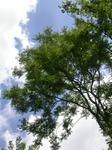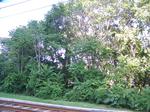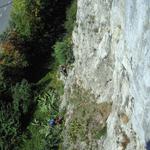| Home | About BFIS | Species List | Risk Analysis | Harmonia⁺ | Resources | Outputs | Mailing List | Registry |
| Contact us | Login | | ||||||
 |

©
Etienne Branquart

©
Etienne Branquart
  
©
Philippe Mariame

©
Etienne Branquart

©
Etienne Branquart

©
Etienne Branquart
 Naturalization in Belgium Naturalization in Belgium
 Invasiveness Invasiveness
More on invasiveness: The tree of heaven is a fast-growing, light demanding and thermophilic pioneer tree species. It grows best on nutrient-rich soils and is very tolerant to dryness and air pollution. It is mostly found in waste and disturbed areas, but can also invade different kinds of forest ecosystems, riparian areas, rock outcrops and semi-natural grasslands. Winged seeds are easily dispersed by wind and water over distances exceeding several hundreds of meters.
 Distribution in Belgium Distribution in Belgium
Established populations

Endangered areas

 Impacts on Species Impacts on Species
 Impacts on Ecosystems Impacts on Ecosystems
More on impacts: Ailanthus altissima successfully displace native vegetation due to its rapid growth and root suckering. It produces allergenic toxins in bark and leaves. As these accumulate in the soil, they inhibit the growth of other plants (allelopathic interactions),favour the formation of monospecific stands and inhibit vegetation succession. Ailanthus also increases soil N content and pH. Ailanthus can reduce soil water availability in case of severe infestation. It may damage roads and other infrastructures due to strong and rapid root development.
References:
AEF (2006)
Cartes provisoires de la distribution de néophytes en Wallonie.
Unpublished document.
CPS-SKEW (2006)
Ailanthus altissima.
From online fact sheets of the Swiss Commission for Wild Plants Conservation.
Clair-Maczulajtys, D. (1985)
Quelques aspects de la biologie de l'Ailanthus altissima (Mill.) Swingle. Étude de la double stratégie de reproduction par graines et par drageonnement en relation avec les métabolites de réserve.
Thèse Univ. Paris VII, 441 p.
Collin, P. & Dumas, Y. (2009)
Revue forestière française LXI: 117-130.
Csiszar, A. (2009)
Allelopathic effects of invasive woody plants species in Hungary.
Acta Silv. Lign. Hung. 5 : 9-17.
Derrick, E.K. & Darley, C.R. (1994)
Contact reaction to the tree of heaven.
Contact Dermatitis 30(3): 178.
Essl, F. & Rabitsch, W. (2003)
Neobiota in Osterreich.
Umweltbundesamt, 432 pp.
ISSG (Invasive Species Specialist Group) (2006)
Online fact sheets
Global Invasive Species Database, IUCN.
Kowarik, I. & Saumel, I. (2007)
Perspectives in Plant Ecology, Evolution and Systematics 8: 207-237.
Kowarik, I. & Säumel, I. (2008)
Water dispersal as an additional pathway to invasions by the primarily wind-dispersed tree Ailanthus altissima.
 Plant Ecology 198: 241-252.
Krivanek, M. & Pysek, P. (2006)
Predicting invasions by woody species in a temperate zone: a test of three risk assessment schemes in Czech Republic.
Diversity and Distributions 12: 319-327.
Lambinon, J., Delvosalle, L. & Duvigneaud, J. (2004)
Nouvelle fore de la Belgique, du Grand-Duché de Luxembourg, du Nord de la France et des régions voisines.
Editions du Patrimoine du Jardin botanique national de Belgique, Meise.
Landenberger, R.E., Kota, N.L. & Mc Graw, J.B. (2007)
Seed dispersal of the non-native invasive tree Ailanthus altissima into contrasting environments.
Plant Ecol. 192: 55-70.
Muller, S. (2004)
Plantes invasives en France : état des connaissances et propositions d'actions.
Publication scientifique du Museum d'Histoire naturelle, Patrimoines naturels n°62.
Rameau, J.C., Mansion, D.& Dumé, G. (1989)
Flore forestière française. Volume 1: plaines et collines.
Institut pour le dévelopement forestier, 1785 pp.
Sladonja, B., Sušek, M. & Guillermic, J. (2015)
Review on invasive tree of heaven (Ailanthus altissima (Mill.) Swingle)conflicting values: assessment of its ecosystem services and potential biological threat.
Environmental Management, DOI 10.1007/s00267-015-0546-5
Swearingen, J., Reshetiloff, K., Slattery, B. & Zwicker, S. (2002)
Plant Invaders of Mid-Atlantic Natural Areas.
National Park Service and U.S. Fish & Wildlife Service, 82 pp.
Säumel, I. & Kowarik, I. (2010)
Landscape and Urban Planning 94: 244–249.
Van Landuyt, W., Hoste, I., Vanhecke, L., Van den Bremt, P. Vercruysse, W. & De Beer, D. (2006)
Atlas van de Flora van Vlaanderen en het Brussels gewest.
Nationale Plantentuin en het Instituut voor Natuur- en Bosonderzoek i.s.m. Flo.Wer vzw.
Verloove, F. (2006)
Scripta Botanica Belgica 39, 89 pp.
Vila, M. et al. (2006)
Local and regional assessments of the impacts of plant invaders on vegetation structure and soil properties of Mediterranean islands.
Journal of Biogeography 33: 853-861.
Weber, E. (2003)
Invasive plant species of the world: a reference guide to environmental weeds.
CABI Publishing, Cambridge, Massachusetts, 548 pp.
Weber, E. & Gut, D. (2004)
Assessing the risk of potentially invasive plant
species in central Europe.
Journal for Nature Conservation12: 171-179.
Webster, C.R, Jenkins, M. & Jose, S. (2006)
Woody invaders and the challenges they pose to forest ecosystems in the Eastern United State.
Journal of Forestry 104(7): 366-374.
|
 |
 |








